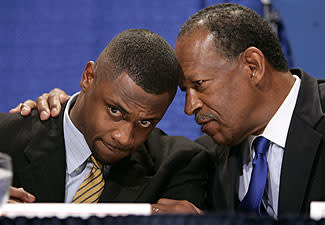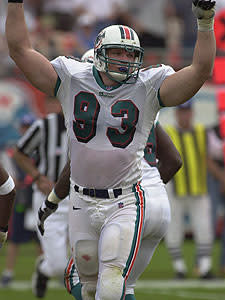Players union in search of solidarity
More: Five critical issues facing union
Mary Moran went from terse to the edge of tears and back again during a 25-minute conversation. As the director of human resources for the NFL Players Association, Moran is more than simply an employee for one of the country's highest-profile unions.
She is a true believer.
"This organization means so much to me," Moran said with no small amount of dignity. "The things that have been done here and established for the players, the progress that has been made, I'm extremely proud to be part of that."
What Moran and others aren't proud of is the lack of solidarity that's created a wedge and sparked controversy during the union's search for its next executive director. A controversy that could undermine whoever wins the union's most powerful post and ultimately create labor strife that could hurt the game.

Vincent, right, lost favor with Upshaw following last year's union meetings.
(Lynne Sladky/AP Photo)
"Does this look good to the outside? No, that's pretty obvious," New York Giants Pro Bowl center and player rep Shaun O'Hara said in February. "But I think we're going to come out of this stronger for having done it this way, for all the negative things that have been put out there … get it all out on the table and talk it through. I think it's going to make us more unified."
This weekend at the union's annual meeting in Maui, one of four candidates – former players Trace Armstrong and Troy Vincent, and lawyers David Cornwell and DeMaurice Smith – will be elected by the player reps from the 32 NFL teams to succeed the late Gene Upshaw as executive director. The union's new leader will then immediately begin plotting negotiations over the collective bargaining agreement with the owners. The agreement expires after the 2010 season, likely setting in motion a lockout by owners and counter moves by the union in federal court.
Yet, before preparing to lock horns with the owners, the union must get its executive staff and paying members on the same page. The divide started at last year's union meetings, grew following Upshaw's death in August and has since taken a turn for the worse.
"Gene deserved better than how he was treated last year … it was his last meeting," Moran said, her voice cracking as she fought back tears.
What Moran is referring to is how a year ago at this time, players such as Matt Stover, Roman Oben, Keenan McCardell and Mike Vrabel told Upshaw that they wanted a succession plan. The belief was that most of them wanted Vincent to be put in place as the successor. Upshaw, a proud and combative man who took few prisoners as a Hall of Fame offensive lineman or during his 25 years as union leader, viewed that request as a challenge to his power and thinly veiled attempt to move him out of office.
While the issue of a succession plan or coup is largely irrelevant in the aftermath of Upshaw's sudden death after a brief battle with pancreatic cancer, the specter of backdoor politics that went with that incident has tinged the search to replace him. And that has put the union on shaky ground as it enters an extremely important time. This is not simply about whether Vincent and Moran, who has been deemed as a threat to Vincent's candidacy, get along. This is about whether any person elected to this job can trust in or develop trust from the people around them.
"The ability to communicate with the membership, with the players, goes hand-in-hand with the ability to negotiate," said Stover, who has spent 16 years as a player rep. "You can't have one without the other and that was the point I was trying to make last year. I wasn't trying to push Gene out. I was trying to put someone in there with him who could reach the players we have today.
"You can write that right at the top of the list, 'communication.' This person who is selected has got to be able to reach the players we have now and get them on board with what's going to happen because it's going to be coming at us fast and furious over the next two years. I could see that as we were going into the meeting last year and I knew it was something that had to be addressed then. We couldn't wait."
Stover has an interesting perspective on the upcoming negotiations. His first season was 1991, which predates free agency and the court rulings that led to it. When he first became a player rep, he sat with men who had been through at least one, if not both, of the player strikes in the 1980s. He sat with guys who had fought in court to finally gain progress in salary negotiations.
Nearly 20 years later, he knows a lot of the edge is gone.
"The players of today have no understanding of how tough the owners can be and how much the players back then sacrificed to get us where we are today," said Stover, the Baltimore Ravens kicker. "You can't explain it to them very easily. They just don't know; they've lived all the benefits of what those guys did."
In essence, today's NFL player is fat and happy. If that life gets messed up too much, he may not be long for the bumpy ride.
"The players have to be told again and again, 'Put your money away, tell your wife or girlfriend not to buy everything she sees, get the house paid off' … the owners are going to push the players hard," said one of the candidates to replace Upshaw who didn't reach the final four. "They're going to make them suffer somehow to break them. These guys don't know what it's like to suffer."
A prominent agent put it another way.
"The owners are going to lock them out, stop free agency, stop the offseason payments, everything, and they're going to see how the players react. Then the owners are going to say, 'You give us two or three percent back, everything will be fine,' " the agent said. "That doesn't sound like a big deal, but what the players don't understand is that two or three percent is huge, it's an unbelievable amount of money. Hundreds of millions, billions of dollars over time."
That money, the agent explained, is the very thing the players will need to solve some of the other issues facing the union, such as pensions or medical benefits and disability for retired players
The agent painted a gloomy picture of what he expects.
"I'll bet you right now, the players will cave. The players aren't tough and I don't care who the next executive director is, he's going to have a tough time getting everybody to stick with him. It's going to get ugly," the agent said. "And you know why? Because the players aren't going to trust the next guy. No matter who it is, there are going to be tons of players who think it was a set up. If it's Trace or Troy, doesn't matter. If it's one of the attorneys, even worse because those guys don't even know how to talk to players."
The prediction follows a search that has gone on for more than six months and has featured sometimes-ugly accusations and angling from all sides. Supporters of Vincent have been particularly angered by how he has been vetted in a public manner.
Vincent has taken one shot after another, from criticism of his education to questions about lawsuits against him to a legitimate-yet-seemingly-underhanded disclosure two weeks ago about his breaching confidential information about agents to criticism last week from Upshaw's widow Terri.
Many claim that Moran has been in the middle of it, which she strongly denies.
"Do you really think that I can influence those 32 player reps in that room?" she said. However, her emotional support of Upshaw and her belief that there was a coup to put Vincent in charge are undeniable. There are also plenty of people on both sides of Vincent's candidacy who believe Moran will be one of several people fired if Vincent is elected.
That has made her involvement in the process problematic, to say the least.

Armstrong spent 15 years in the NFL as a player.
(Alan Diaz/AP Photo)
In January, NFLPA president Kevin Mawae and acting executive director Richard Berthelsen received a letter from four U.S. congressmen questioning the search process. The congressmen stated in the letter that "recent news reports in the New York Times on January 4, 2009 and the Washington Post/Associated Press on December 28, 2008 regarding the Executive Director search process have caused us a measure of concern as to the transparency and compliance with both applicable Department of Labor rules and regulations, and the NFLPA Constitution as the NFLPA conducts its search process."
Even though the congressmen explained the reasoning behind their investigation, the union felt compelled to find out if a candidate was behind the letter. Berthelsen instructed Moran, who is the daughter of Virginia congressman Jim Moran, to find out more information. She asked her father to ask around. Later in January, Jim Moran gave information to his daughter. The information was typed up as a two-page memo with only Jim Moran's name and phone number at the bottom as a contact. The memo spelled out that Vincent was behind the letter.
Mary Moran said this week that Mawae instructed her to send a copy of the memo to the other members of the union's executive committee, which was conducting the search for candidates. Mawae is on the committee, along with 10 other current and former players. The committee was in charge of whittling the initial batch of applicants to the ones who will be in Hawaii this weekend.
Upon receiving the memo, several members of the committee were upset that someone with perceived bias would author such an investigation. Further, the investigation appeared decidedly one-sided.
Mawae and fellow committee member McCardell went to see the congressmen the week before the Super Bowl and the congressmen held a conference call on Feb. 2 to repudiate the claims in the memo by Jim Moran and, in turn, criticize him for trying to protect his daughter.
While it all makes for a great soap opera, unraveling the tangled web of who said what and why is no longer truly important. It is the ripple effect that matters, the bigger picture of what happens going forward and how the next executive director is able to lead.
If he can.
